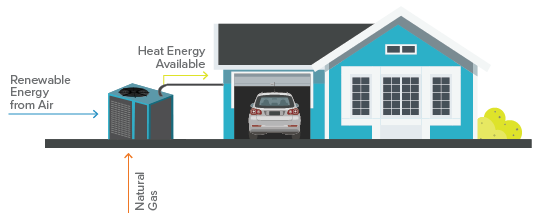About Gas Heat Pumps
What is a Gas Heat Pump?
Gas heat pumps are a highly energy efficient technology used for space heating and cooling, as well as water heating in commercial and residential sectors. Non-residential products are currently available, but residential gas heat pumps have not been commercialized yet in North America. The Collaborative expects residential products have hit the market in 2025.
These products operate similarly to other heat pump technologies where heat is moved from one place (“the source”) to another place (“the sink”). A common example of heat pump technology is how a refrigerator moves heat from within the unit (“the source”) to outside the unit (“the sink”) by using refrigerants and heat exchangers. Like electric heat pumps, gas heat pumps efficiently move heat from the outside of a facility to its interior, and like electric heat pumps, some gas heat pumps can reverse this process for a cooling effect.
Gas heat pumps differ from their electric counterparts in the fuel they use and in how they pressurize refrigerant. There are three types of gas heat pump technologies that manufacturers are developing: engine-driven vapor compression, sorption (absorption/adsorption), and thermal compression. Each type uses different refrigerants and pressurization methods.
The illustration “How a Gas Heat Pump Works” demonstrates how gas heat pumps extract heat from surrounding air and transfer it to heat or cool buildings in a simple three-step process: 1) Outside air is pulled into the system. Fans pull warmth out of the air from the “source” into the heat pump, 2) Heat from natural gas combustion is added to ambient heat. Heat from the air and a gas burner is transferred to the refrigerant, 3) Heated air is pumped into the home.
How a Gas Heat Pump Works

Interested in Learning More?
Check out our resources.


